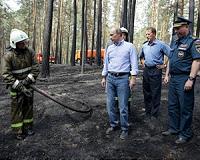| . |  |
. |
Moffett Field CA (SPX) Aug 26, 2010 If the world could make one major change that would stave off climate change, what would it be? Stanford University engineering scientist Mark Jacobson has the answer: get rid of black soot. The dense carbon particles are the result of incomplete combustion of a hydrocarbon from engines, forest fires, and power plants. Ever seen discolored walls above the baseboard of an electric heating unit? That's black soot. Black soot is responsible for somewhere between 25 percent and 50 percent of observed global warming, recent studies have shown. That's because being dark it absorbs a lot of sunlight and converts it to infrared (heat) radiation, emitting it back to the surrounding air. When it settles onto snow or ice, the soot effectively warms those surfaces too, contributing to melt. To give a comparison, black soot warms the air up to 2 million times more than the same amount of CO2. Jacobson compared the effects of curbing back soot to reductions in CO2, methane, and several dozen other molecules. Using computer simulations, he found that controlling soot would reduce temperatures faster than controlling CO2 over the next 25 years, by up to 23 percent. After that, CO2 is still the major bogeyman in the atmosphere. But with immediate relief from soot, some of the tipping points could be delayed. Jacobson published his findings in the latest Journal of Geophysical Research. Although CO2 emissions are the primary cause of climate warming over the past century, and ultimately need to be curtailed, black soot removal provides immediate relief. That's because the carbon-heavy molecules settle out of the atmosphere more quickly - in just a few weeks - so stopping their production now means tangible, immediate reversal of warming. The good news is that we have the technology to curb back soot. Scrubbers on power plants do the trick, as do clean burning ovens for the world's poor, and electrified transportation.
Engineering the skies While that might counter global warming to some extent, a new research paper published last month in the journal Nature Geoscience finds that it's no solution to the planet's climate woes and may in fact cause certain parts of the world to receive less precipitation, even as global temperatures stabilize. Researchers led by the engineering department at Carnegie Mellon University examined land temperature and precipitation differences in 23 regions. In some places, like Australia and eastern Africa, precipitation remains nearly the same as business-as-usual levels under solar radiation management. But other places, like Canada and northern Asia, precipitation rates would drop off below baseline levels. In other words, monkeying around with solar radiation would not revert the whole planet back to the norm. If the goal is to restore late-twentieth century climate, this is no way to do it. It only gets worse with time, by 2070 these differences become acute. China and India, for example, move in opposite directions, with China becoming warmer and drier and India becoming cooler and wetter, relative to the norm. "Although it may be possible to "fine tune" the hydrological response by injecting aerosols with different optical properties at different latitudes or altitudes, no proposal yet exists for how this might be implemented in practice and some variability remains inevitable," write the researchers. They warn that these differences in regional response would make international negotiations even more sticky than they already are. After all, for who's climate are you normalizing? And since just one or two countries would be in charge of implementing solar radiation management technologies, that gives them a lot of power. "In other words, as the level of modification required to compensate for anthropogenic greenhouse gas forcing increases, the relative appeal of different levels of [solar radiation management] depends on the region considered and the variable (temperature or precipitation) that is deemed most important." Other problems? Solar radiation management would not solve the other issues inherent in higher CO2 levels, since they would presumably remain the same or be increasing. Earthly life forms would still be impacted, and the oceans would continue to acidify.
Share This Article With Planet Earth
Related Links Hot Zone blog entry Climate Science News - Modeling, Mitigation Adaptation
 German scientist hands Putin frosty climate rebuke
German scientist hands Putin frosty climate rebukeMoscow (AFP) Aug 23, 2010 Prime Minister Vladimir Putin queried Monday whether man was to blame for climate change on a visit to the remote Russian Arctic, only to find himself bluntly contradicted by a German scientist. Putin, known for his tough-guy visits to his country's most far-flung areas, went by helicopter to a Russian-German research station on an island at the mouth of the Lena River in the Far Eastern Yak ... read more |
|
| The content herein, unless otherwise known to be public domain, are Copyright 1995-2010 - SpaceDaily. AFP and UPI Wire Stories are copyright Agence France-Presse and United Press International. ESA Portal Reports are copyright European Space Agency. All NASA sourced material is public domain. Additional copyrights may apply in whole or part to other bona fide parties. Advertising does not imply endorsement,agreement or approval of any opinions, statements or information provided by SpaceDaily on any Web page published or hosted by SpaceDaily. Privacy Statement |